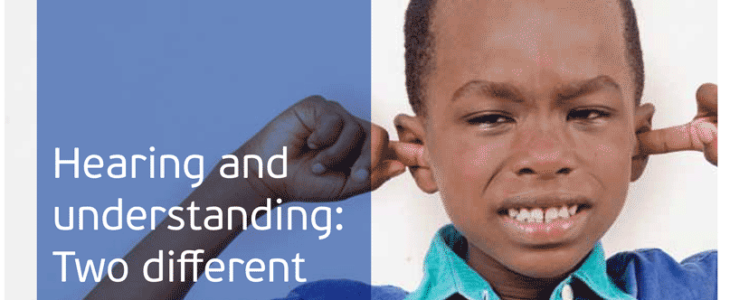

Parents and teachers complain
that a child simply “does not
listen” or “appears deaf” and
cannot follow instructions
or often forgets what they
have been asked to do.
They seem distracted and
often misinterpret verbal
information. This is the typical
presentation of a child with an
auditory processing difficulty.
Hearing loss must be ruled before considering an
auditory processing difficulty. Although auditory
processing starts in the brain, there are no scans
that can be done to confirm it. It is by ruling out other
hearing and learning problems that it is diagnosed. Auditory
processing difficulties often co-exist with other conditions
such as attention deficit / hyperactivity (ADD and ADHD)
and dyslexia.
We know that the complex process of interpreting what
is heard has an impact on a child’s ability to learn speech
and language, manipulate sounds and words (develop
phonological awareness) and understand how language
works (acquire language concepts). By definition then,
auditory processing is the way the brain processes, stores,
manipulates and uses information that is received through
the auditory channel (ear).
In essence, a child with an auditory processing difficulty will
have problems in at least one of the five tiers of processing:
• Auditory attention: The ability to recognise the
direction a sound is coming from, or to listen to someone
talking if there is background noise such as music
playing, children chattering or the general noise of a
classroom where learning is happening.
• Auditory memory: The ability to hold
information in short-term working
memory in order to process it and
respond to it. For example a set of
numbers (a telephone number), a set
of words (a shopping list) or a sentence
(instructions or a dictation).
• Auditory discrimination: The ability
to identify different environmental
noises (e.g. a cock crow vs. a vacuum
cleaner working), the ability to notice
and copy sound patterns (e.g. rhythmic
drum beats or clapping sequences) and
the ability to notice subtle differences
in speech sounds (e.g. a child may not
realise that the words ‘mail’ and ‘nail’
sound different)
• Auditory analysis and synthesis:
The ability to break speech up
into words, syllables and sounds
(phonemes) and blend them back
together again. For example: the word
‘mat’ can be broken up into three
sounds, m-a-t. If you say ‘mat’ but don’t
say ‘m’ you are left with ‘at’. ‘Mat’ is
one syllable. If you say ‘mat’ and add
the syllable ‘-ter’, you have ‘matter’.
And the ability to guess the last word
or sentence in background noise or
when speech is interrupted, e.g. “What
is the … with you?”
• Auditory comprehension: The ability
to put sounds together to understand
language.
A child with an auditory processing
difficulty may be unable to say a number
of speech sounds correctly and may
consistently substitute one sound for
another, e.g. f / th, as in fumb / thumb and
teef / teeth). These children often confuse
similar words or sounds, e.g. they struggle
to say words like ‘hospital’ and ‘animal’
and they may say ‘hopstibal’ and ‘amimal’.
They very likely have poor vocabularies
and sentence structure (grammar). These
weaknesses may well translate into
problems with sound-symbol association
when they begin to read and so will battle.
They may take extra time to make the
association between the letters of the
alphabet and the sounds that these letters
make in words. This results in challenges
with learning to spell, read fluently and
comprehend what is being read. Often
children with poor auditory perception are
poorly organised, struggle with sequential
processing (doing things in order), cannot
complete tasks within given time limits and
lack a methodical and sequential approach
to tasks.
So how then can auditory processing difficulties be overcome within the classroom?
To adapt the physical learning
environment (classroom) ask
questions like:
• Does noise reverberate, or echo, in
my classroom?
• Could I reduce the echo in my class
by putting up curtains, adding more
carpets or placing tennis balls on
the bottom of the children’s’ chairs
to reduce noise levels?
• Could I introduce a ‘talking stick’ to
encourage one person to speak at a
time (the person holding the stick)
and others to look at and listen to
the person who holds the stick?
Make provisions for children with
auditory processing challenges:
• Use visual cues to help children
understand what they hear, e.g.
children can use their fingers to
remember the number of things
they must do.
• Develop visual schedules to help
children organise themselves and
understand the sequence of the
days’ events. The schedules will help
the child remember what comes
next. E.g. 1. Begin with a prayer, 2.
Writing, 3. Reading, 4. Play time,
5. Wash hands, 6. Come inside, 7.
Maths, 8. Prayer and home time.
• Make use of short, simple sentences
when giving instructions and repeat
or rephrase the instructions to help
understanding.
• Allow children to repeat instructions
they are given. This ensures that
they have clearly understood what
they have been asked to do.
Develop compensation skills:
• Explain to the children that we all
get it wrong sometimes.
• Encourage them to ask questions for
clarification.
• Allow them to choose the best
seating for themselves in the class
and encourage them to provide
feedback about their position or ask
to be moved if they can not see or
hear.
• Encourage them to ask themselves
these questions, perhaps put them
up near the front of the classroom:
What do I know? What do I need
to know (or what’s missing)? How
do I get the information I need?
This will help children to problem
solve and empower them to be more
independent in the classroom.
Auditory processing skills continue
to develop and be refined throughout
the teenage years so they should be
given ongoing attention. Unfortunately,
the advancement of technology has
resulted in the reduction of family time
(listening, talking and working together
to complete chores) and an increase in
screen time, which requires very little
in terms of a well-developed auditory
system. As professionals and educators
we should be encouraging parents
to keep screen time to a minimum in
the home and rather engage in real
communication around the dinner
table. Reading together enhances the
development of auditory perceptual
skills and should ideally be a daily
activity in the lives of all children.
Bibliography/ References
How children hear — What is auditory processing? Written by Dr. Stephanie Long, Audiologist http://www.auditoryprocessing.com.au/apd-symptom-checklist/
Classroom Listening Assessment: Strategies for Speech-Language Pathologists
Cheryl DeConde Johnson, Ed.D. SEMINARS IN SPEECH AND LANGUAGE/VOLUME 33, NUMBER 4 2012
DiMaggio, C., & Geffner, D. (2003, November). Prevalence of attention deficit hyperactivity disorder, speech and language delay, reading difficulties, and family factors associated with CAPD in children. Paper
presented at the Annual Convention of the American Academy of Audiology, Salt Lake City, UT
Keller, W. D. (1998). The relationship between attention deficit hyperactivity disorder, central auditory processing disorders, and specific learning disorders. In G. Masters, N. Stecker, & J. Katz (Eds.), Central
auditory processing: Mostly management (pp.33-48). Boston: Allyn & Bacon.
http://www.drbelsham.com/adhd-and-screen-time

